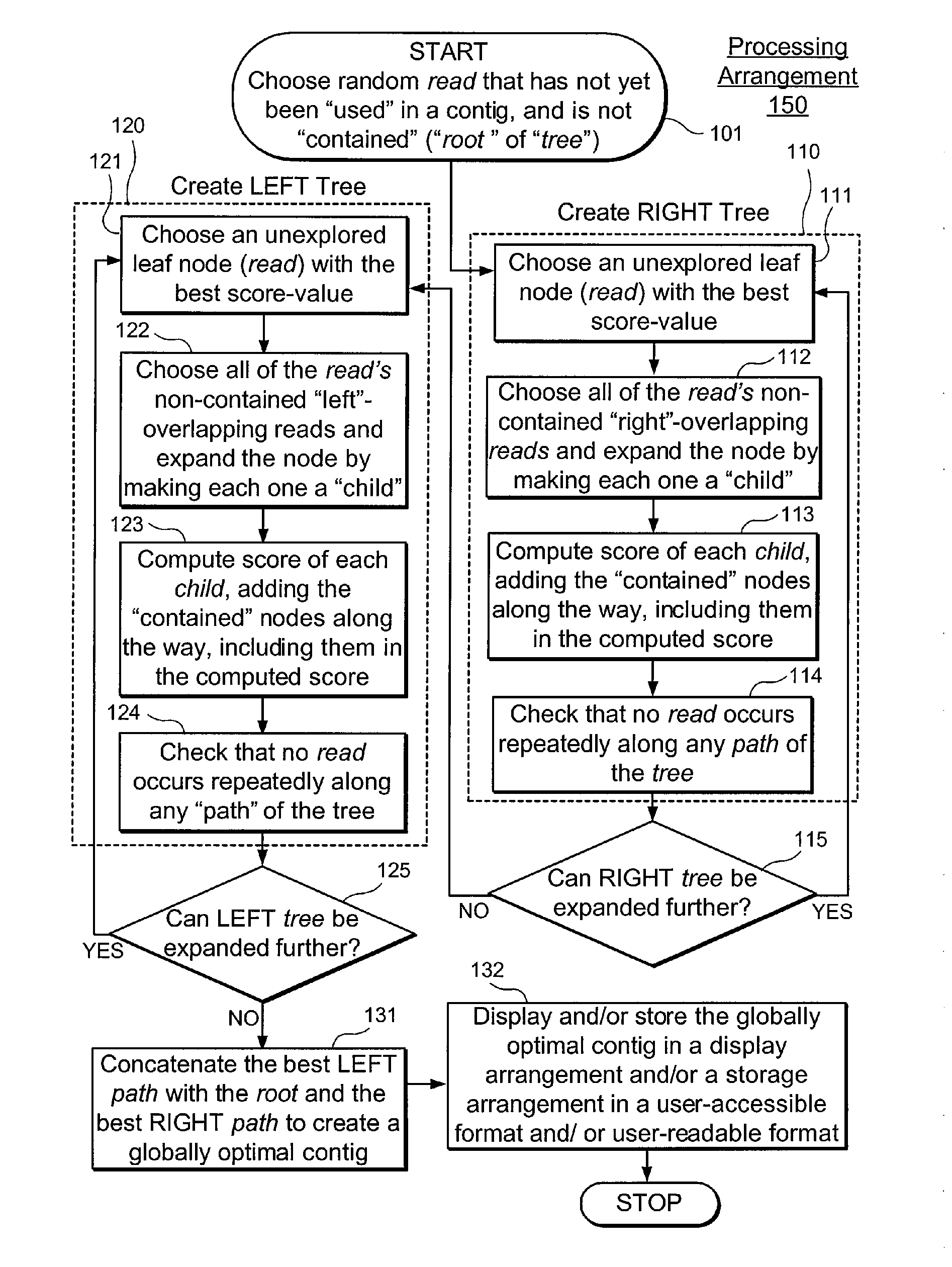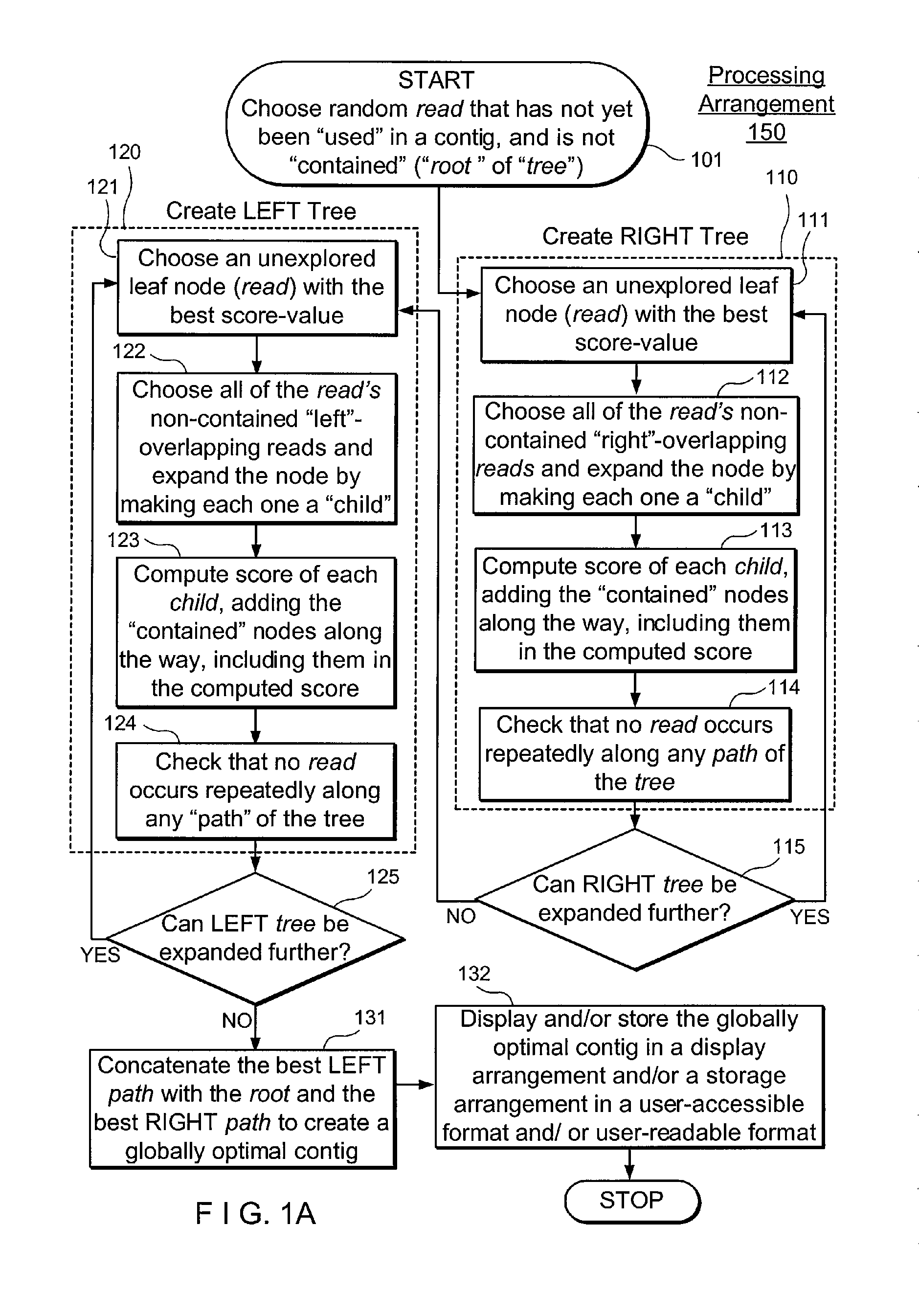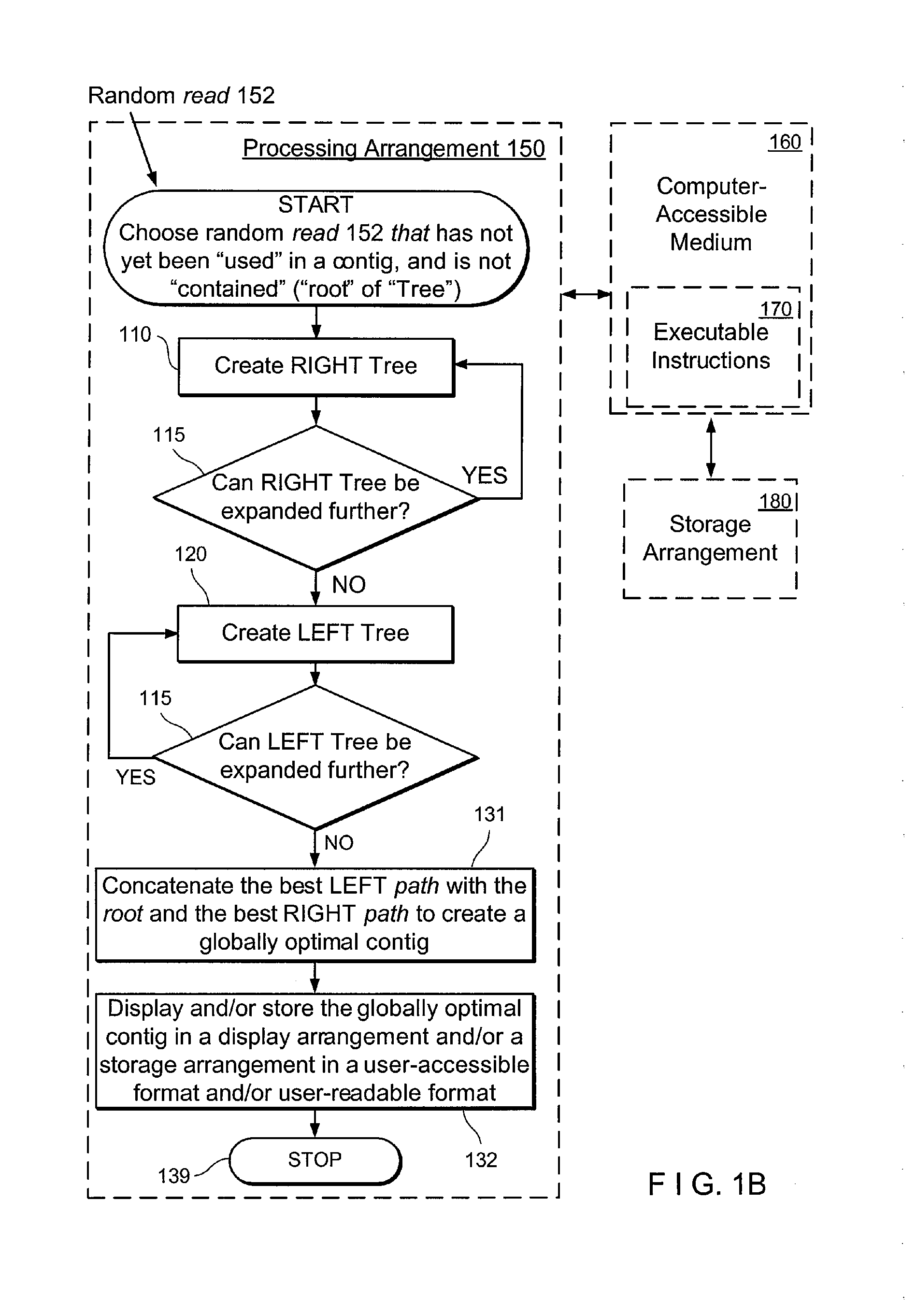However, the algorithms at the core of this SBH technology appear to be incapable of exploiting many other advances in sequencing technologies that focus only on producing non-contextual short-sequence-read data.
Currently available technologies do not achieve the objectives of a scalable whole-genome haplotypic sequencer.
For example, such conventional technologies generally generate relatively short genotypic reads (e.g., 30 bps-300 bps, without haplotypic and locational context); they generally are corrupted by errors, such as low-quality base-calls or compression of homopolymeric runs; and they frequently lack long-range
contextual information (except what may be available through a limited amount of mate-pair data).
These shortcomings in the currently available technologies generally affect the yield and speed of the resulting technology and can have a debilitating effect on the complexity of the
assembly procedure.
Despite these improvements, however, two predominant limitations have remained with such prior technology: the read-lengths cannot exceed about one Kb, and the reads have no associated
contextual information (e.g., no chromosomal location or haplotypic disambiguation).
Several new
massively parallel sequencing methods have been proposed to address many of these issues; but, while most of these methods have provided lower latency and higher
throughput at a lower cost, they have neither improved the read lengths nor enabled addition of
contextual information.
While such advancements should have a positive effect on various exemplary embodiments of the present disclosure, Pacific Biosciences' technology, in isolation, generally provides only limited improvement over other related technologies, as it lacks long-range information (e.g., information spanning over genomic regions of size 150 Kb or greater, or 100 Kb or greater).
These sequencing technologies have found many applications: e.g., SAGE profiling, cDNA sequencing, nucleasome positioning and
metagenomics, but do not seem to be appropriate or cost-effective for
population genomics, personal
genomics or
genomics-based individualized
medicine, for example.
In addition, since, in each cycle, there is no unambiguous way of determining exactly how many bases get incorporated, if the genomic fragment has a run of a single
nucleotide base, 454-instrument will not be able to tell the run length, and thus produce a compression of the homopolymeric run to a single base.
Similar to the other technologies, the read-lengths from this technology are even shorter and may have little or no contextual problem; despite being able to read almost 1× coverage of a genotypic human genome in a single run, these reads fail to assemble to give any meaningful information.
Even in simple resequencing applications, lack of contextual information poses serious difficulties in placing the short sequence reads in the reference sequence efficiently and correctly.
However, a massively large number of such non-contextual short-reads can only lend themselves to biological interpretations and biomedical applications when they can be assembled into contiguous overlapping sequences encompassing the information contained in each haploid
chromosome.
Even though researchers have significantly improved the ability to create a large-coverage
library of sequence reads relatively quickly and cheaply, counterintuitively, the resulting technology has not increased the value of the information, thus obtained.
It is because most of these technologies produce shorter read-lengths, corrupt the data with different forms of base-read errors, and are not amenable to
assembly processes that would provide useful long-range information, for example.
In this manner, these greedy algorithms may trade computational complexity against loss of genotypic information, number of gaps separating contigs and accuracy of the
assembly.
Certain complications occur as one needs to deal with sequence-read-pairs that contain one in the other, chimeric sequence reads, sequences that may contain low-quality base-calls or regions of vector sequences, or sequence reads originating from repetitive regions.
Consequently, unlike various exemplary embodiments of the present disclosure, Celera WGA's
branch-and-bound approach does not provide a significant
performance improvement in practice, and forces them to adapt the implementations to a
hybrid approach that mixes
branch-and-bound steps with greedy steps, in direct contrast to some exemplary embodiments in accordance with the present disclosure.
Like Celera WGA assembler, Arachne has also found applications in large-scale genome assembly projects, but suffers from various problematic features discussed earlier (e.g., potential misassembly of rearrangements, haplotypic ambiguities, etc.).
Thus it incorporates several
heuristics to disentangle clusters of erroneous edges, which may confuse the
algorithm to explore incorrect superpaths and getting it stuck with incorrect solution, especially when the quality of base-calls falls below a certain threshold.
EULER tries to circumvent these problems by an error-correction process, which is not always foolproof.
However, none of these algorithms use long-range information to, e.g., score solutions, and are generally not flexible enough to adapt to other long-range data.
In addition they have played a significant role in validating sequence assemblies that are prone to massive amount of otherwise undetectable errors.
However, the key assumptions of that paper, namely, optical map assembly algorithms can be presumed to scale to any
genome size in the presence of any error process (e.g., optical chimerism), has not proven to hold in reality.
Granted that at intermediate scale (e.g.,
bacteria sized genomes)
optical mapping has been phenomenally successful in cost,
throughput and accuracy, and that Aston-Mishra-Schwartz strategies have worked reasonably well in those cases, myriads of problems arise as one attempts to apply the same strategies to
eukaryote-sized genomes, or desire to distinguish haplotypes.
However, a combinatorial version of the problem for finding a best map assembly may be theoretically computationally infeasible, e.g., it may be NP-hard and there may be no corresponding polynomial-time approximation scheme (PTAS).
However, by appropriate design of an experimental set-up, it has been demonstrated that one can constrain the problem to only polynomially feasible instances of a normally infeasible problem, as described, e.g., in T. Anantharaman et al.
Although
optical mapping methods may have been used to construct genome wide ordered restriction maps of whole genomes, such methods have not been used to assist genome-wide
shotgun assembly of short sequence reads from any independent sequencing technologies in order to generate
haplotype sequences.
However, the problem of assembling such short sequence reads anchored to the restriction fragments can rely on exploiting the implicit locational information in the data and thus can require first explicitly creating an ordered restriction optical map and then interpreting the short reads (thus positionally anchored) appropriately via a technology-specific Bayesian prior model, for example.
However, this approach may not cure certain problems because compression of homopolymeric can run as well as optical chimerism.
However, several implicit assumptions and hitherto unknown facts appear to impede progress along this direction.
Exacerbating these fundamental hurdles, one also faces the added difficulty of dealing with highly intractable computational problems, which can arise from the requirement to interpret non-contextual short-range data from many individuals and many subpopulations (with unknown
population stratification) relative to any genotypic reference sequence.
However, in this assumption, it remains unclear as to how one expects haplotypic ambiguities and structural variations to be handled satisfactorily.
With these traditional technologies, even more troublesome is the assumption that all sequence variations in the human genome are single
nucleotide mutations, which has been seriously questioned by the rather serendipitous detection of copy-number polymorphisms through array-CGH technologies.
However, the technology that revealed these polymorphisms and are currently widely used to study these variations, namely array comparative genome hybridization (array-CGH are incapable of characterizing their exact long-range structural properties (e.g., involving chromosomal inversions, translocations, segmental deletions, segmental duplications, and large-scale
aneuploidy) and are likely to be of limited utility.
Importantly, many of these copy-number variations likely cannot be detected, nor can they be positionally and haplotypically located by using any of the conventional short-range non-contextual
shotgun sequencing technologies that are currently available.
While such paired-end sequencing approach can be used to identify limited amount of structural variations (in addition to copy-number variations), they can lack haplotypic disambiguation, and may fail when the long-range rearrangement events span much larger-regions than what can be spanned by the clone length (e.g., a translocation event that moves a segment from one
chromosome into another without changing its copy-number).
The difficulties described above undermine the reliability of
population-wide genomic studies.
 Login to View More
Login to View More  Login to View More
Login to View More 


